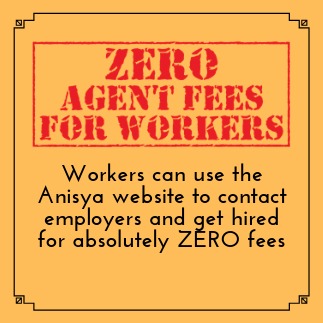Employers are welcome to use the Anisya website for free to connect with and employ domestic workers without going through an agency. We also offer a paid upgraded version of the website that offers more functionality. If you would prefer to outsource the whole hiring process, Anisya provides a full-service hiring package, more details can be found here.
This article assumes that you (as a future employer) have already gone through the thought process of why you require the services of a domestic worker, how to include this new person into your family and daily life, as well as the related costs of employing a worker.
Step 1: Meet the hiring requirements as an employer and review the employer guidelines

Before you can hire a domestic worker, you have to meet a set of requirements set by Singapore’s Ministry of Manpower. More details can be found here.
Step 2: The Search begins
Once you have fulfilled these requirements, you can start your search and interview process for a domestic worker. Talk to your friends, neighbors or colleagues who may not need the worker’s service for a good reason. Alternatively, you can search through Anisya’s database for a worker looking to transfer and use the Anisya Hiring Dashboard to keep track of your communications with the various workers.
 All workers who have advertised on the Anisya website have sent us their work permit numbers, this allows us to retrieve their employment records from the MOM database. You can also access this information directly through the MOM website. You should also ask to speak with a worker’s current employer to find out more about her strengths and weaknesses. Some workers have recommendation letters from their current and previous employers and this is indicated on the Anisya website. Having a good relationship with the current employer is typically a good sign.
All workers who have advertised on the Anisya website have sent us their work permit numbers, this allows us to retrieve their employment records from the MOM database. You can also access this information directly through the MOM website. You should also ask to speak with a worker’s current employer to find out more about her strengths and weaknesses. Some workers have recommendation letters from their current and previous employers and this is indicated on the Anisya website. Having a good relationship with the current employer is typically a good sign.
To avoid disappointments and wasted time, ensure that workers are able to transfer before scheduling interviews. For a domestic worker to be eligible for transfer, she must meet the following criteria:
- have at least 30 days validity on her current work permit
- have passport validity of at least 7 months
- have medical examination completed within the last 5 months
- must have her current employer sign the “release papers”
Transfer workers would have already met the basic eligibility requirements for working in Singapore.
Step 3: Schedule Interviews with workers
 Workers who have a day off (a weekly day off is now mandatory for new contracts signed from 1 Jan 2013) will typically be available for interviews on Sunday. Try to schedule a few interviews that day. We recommend interviewing workers at your home; you can see how the worker interacts with your family and pets, and maybe even do a quick cooking test if that’s a priority for you. The worker also gets to see her work and living environment, which is good to set her expectation.
Workers who have a day off (a weekly day off is now mandatory for new contracts signed from 1 Jan 2013) will typically be available for interviews on Sunday. Try to schedule a few interviews that day. We recommend interviewing workers at your home; you can see how the worker interacts with your family and pets, and maybe even do a quick cooking test if that’s a priority for you. The worker also gets to see her work and living environment, which is good to set her expectation.
Some workers might be reluctant to interview at your home if it is not easily accessible by public transport. You can address this by offering to pay for their taxi fare.
Have an open discussion with the worker around monthly salary and whether you might need her to work on off-days. Compensation for working on an off-day is calculated as 1/26 of her monthly salary. Some workers might ask to have public holidays off. You should also discuss if you’ll be providing annual leave (paid or unpaid) and how you’re thinking about future salary increments. Some experienced workers might have a salary expectation higher than what you’re prepared to pay. To reach a middle ground, you can have a probationary period (3 months is a good gauge) with a lower starting salary, and then increase it to her expected level upon reaching satisfactory performance. All this will of course need to be documented in your employment contract.
Not sure of what salary to offer? Anisya has compiled some preliminary salary statistics as a guide. There is a gradual salary increment over time but not a fixed correlation. We have found that higher salaries typically come in when a worker stays longer with the same family and in doing so, reaps the benefits of ongoing increments. To check if your salary offer is competitive with other employers, use this salary comparison tool.
As you go through your interviews, you can update the status for each worker on the Anisya Hiring Dashboard with some comments and also flag each worker as shortlisted, pending or declined (these statuses are only visible to you for tracking purposes and will not be public)
IMPORTANT note about hiring Filipino worker: the Filipino government runs the Philippines Overseas Employment Administration (POEA), which mandates a minimum wage of SGD575 (as at July 2017). This becomes pertinent when the worker goes on home leave. As an employer, you will have to sign a declaration stating that you have met this minimum wage requirement. Not having this documentation properly done could result in your worker’s inability to return to Singapore from the Philippines.
In addition to this, if your worker is going back for vacation to the Philippines, a POLO performance bond worth SGD7000 is required before your worker can acquire an OEC. Take note that this POLO performance bond is different from the MOM security bond worth SGD5000. You can typically purchase the POLO performance bond (SGD7000) from the same insurance company where you purchase the MOM security bond. If your worker will not likely be having a vacation to the Philippines then you can skip this. Please contact the Philippines Embassy for more details.
Step 4: Make an offer to the worker
When you have found a worker who meets your requirements, you can make her an offer with details on salary, off days, annual leave, duties, working hours and employer obligations (e.g. provision of private sleeping area, meals, personal hygiene products, etc). Be as clear about these terms as possible. Anisya customers (employers using Anisya’s full hiring service) will be provided with a checklist to validate all these finer details. Misunderstandings around seemingly basic matters like what meals will be provided could potentially sour the relationship. Agreeing to things like annual leave would also come with additional obligations, like doing the necessary paperwork with the foreign government to allow the return trip of the worker.
Coordinate a transfer date with her current employer. Make sure the worker’s work permit continues to remain active until you submit your work permit application. The worker’s current employer might be expecting the arrival of a new worker herself and could be in a hurry to cancel your prospective hire’s work permit. Make sure this is properly coordinated. If your prospective worker’s work permit is cancelled during this process, she will have to leave the country and the process to bring her back into Singapore becomes more complicated.
Draft up an employment contract including the terms of employment. MOM has provided an overview of key terms to include in this employment contract.
Ensure that her current employer has sent the worker for the 6 monthly medical examination if required, this can be checked through MOM’s Work Permit Online system. Obtain a copy of worker’s passport and work permit; you will need this to submit the work permit application and to buy insurance for her.
Step 5: Apply for Work Permit and Buy Insurance/Security Bond
Submit a work permit application for the foreign domestic worker using your SingPass at this MOM website. If you have all your documents in order and meet MOM’s requirements, you will receive an In-Principle Approval (IPA).
You can now purchase the required Medical Insurance and Security Bond Requirements. Purchase your maid insurance and you will be able to issue the new work permit as early as the next working day.
Set up your GIRO account by mailing in the form with your internet banking details for the domestic worker levy. If you have previously employed a domestic worker and set up a GIRO account with no changes in banking details, the IPA letter will state whether or not you need to re-submit an application.
You will also need to complete the security bond form from MOM.
Step 6: Issue Work Permit
Issue the work permit after all requirements from the IPA have been met. You will need an acknowledgement code from the insurance company to issue the work permit. You can then meet the worker to sign the required set of forms and you can also sign the employment contract at this stage. The worker should only start work with you after the new work permit has been successfully issued.
We hope you have found this information useful!



